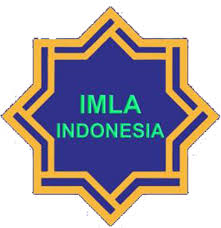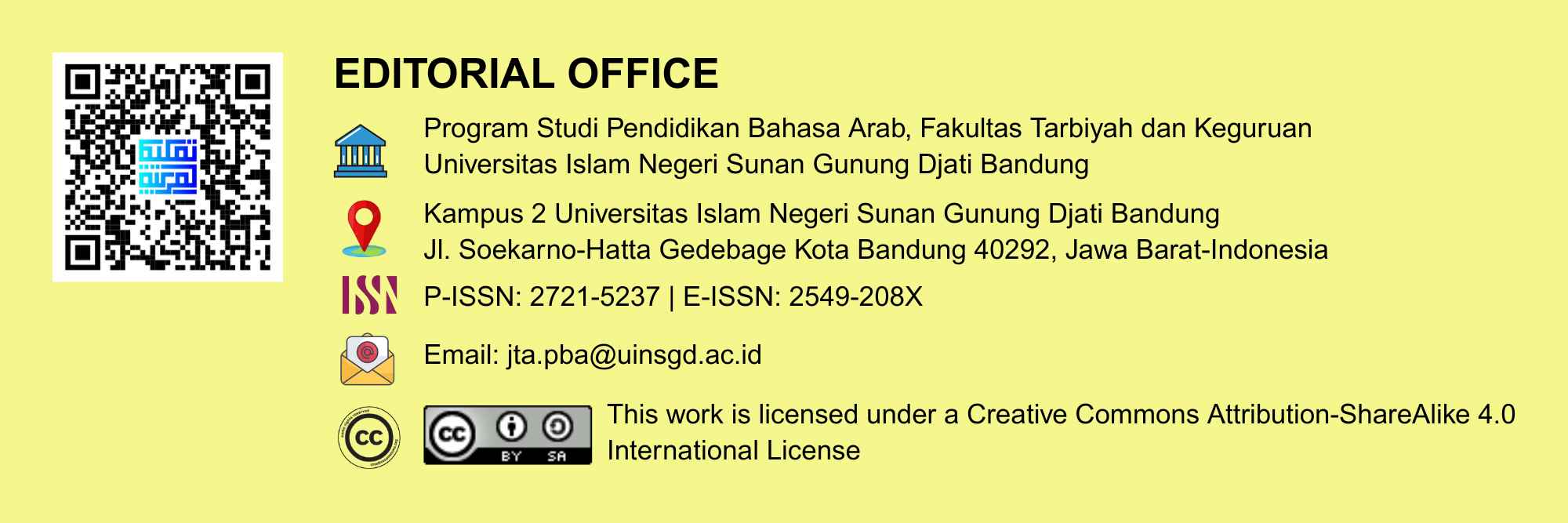Enhancing Arabic Language Learning Through CLIL in the MBKM Curriculum
DOI:
https://doi.org/10.15575/jta.v9i1.44792Keywords:
Arabic language learning, CLIL, MBKM curriculum, Student motivation and proficiencyAbstract
The transition from the Indonesian National Qualifications Framework (KKNI) to the Merdeka Belajar Kampus Merdeka (MBKM) curriculum introduces new challenges for Arabic language learning in higher education, particularly the need for flexible and integrative teaching approaches. This study explores the implementation of the Content and Language Integrated Learning (CLIL) approach within the MBKM framework. It examines its effects on students’ motivation and proficiency in reading and writing Arabic. Employing a quasi-experimental design with a non-equivalent control group, the sample consisted of an experimental group from class MPI-IA (38 students) and a control group from class MPI-IB (40 students). Data were collected through questionnaires, reading and writing tests, classroom observations, and semi-structured interviews and were analyzed using descriptive statistics and independent sample t-tests. The results demonstrate that the CLIL approach significantly enhances students’ motivation and Arabic language skills while also supporting a deeper understanding of Islamic education content through the integration of Arabic texts. These findings suggest that CLIL is a promising pedagogical strategy for aligning Arabic language instruction with the objectives of curriculum transformation and the development of interdisciplinary competencies.
References
Adipat, S. (2021). Developing Technological Pedagogical Content Knowledge (TPACK) Through Technology-Enhanced Content and Language-Integrated Learning (T-CLIL) Instruction. Education and Information Technologies, 26(5), 6461–6477. https://doi.org/10.1007/s10639-021-10648-3
Ainun, F. P., Mawarni, H. S., Sakinah, L., Lestari, N. A., & Purna, T. H. (2019). Identifikasi Transformasi Digital Dalam Dunia Pendidikan Mengenai Peluang dan Tantangan di Era Disrupsi. Teachin.Id, 6(1), 1570–1580. https://doi.org/10.31316/jk.v6i1.2778
Akpur, U. (2020). Critical, Reflective, Creative Thinking and Their Reflections on Academic Achievement. Thinking Skills and Creativity, 37(1), 100683. https://doi.org/10.1016/j.tsc.2020.100683
Al-Qurni, A. H., Hassanin, Y. A., Zein, K. A. M., & Abdulghani, M. A. F. (2024). Holy Kaaba Names in the Holy Qur’an: A Stylistic Study. Journal of Islamic Thought and Civilization, 14(1), 372–386. https://doi.org/10.32350/jitc.141.22
Al-Sabbagh, R. S. (2022). The Impact of Interactive Whiteboard Use on Teaching Grammar to Grade Seven EFL Learners. International Journal of Learning and Teaching, 8(3), 160–167. https://doi.org/10.18178/ijlt.8.3.160-167
Alam, A. (2022). A Digital Game based Learning Approach for Effective Curriculum Transaction for Teaching-Learning of Artificial Intelligence and Machine Learning. International Conference on Sustainable Computing and Data Communication Systems, ICSCDS 2022 - Proceedings, 69–74. https://doi.org/10.1109/ICSCDS53736.2022.9760932
Alanazi, M., & Alqarni, M. (2022). The Very First Sentence in Research Article Introductions: A Rhetoric Comparative Approach. Heliyon, 8(8), e10241. https://doi.org/10.1016/j.heliyon.2022.e10241
Albab, U. (2019). Motivasi Dalam Pembelajaran Bahasa Arab Sebagai Bahasa Asing. TAMADDUN: Jurnal Kebudayaan Dan Sastra Islam, 19(1), 32–48. https://doi.org/10.19109/tamaddun.v19i1.3398
All, A., Castellar, E. N. P., & Van Looy, J. (2021). Digital Game-Based Learning Effectiveness Assessment: Reflections on Study Design. Computers and Education, 167, 104160. https://doi.org/10.1016/j.compedu.2021.104160
Anggi Nurul Baity, & Putri Kholida Faiqoh. (2022). Optimizing Arabic Learning for University Students through 4C Skills of 21st Century. Kilmatuna: Journal Of Arabic Education, 2(2), 281–292. https://doi.org/10.55352/pba.v2i2.79
Arifin, Z., Namira, S., K, M., Engkizar, E., Asril, Z., & Rahawarin, Y. (2023). The Problems of Students and Teachers in I’rab Learning at Islamic Boarding School. Istawa : Jurnal Pendidikan Islam, 7(2), 144–173. https://doi.org/10.24269/ijpi.v7i2.4587
Banegas, D. L., Montgomery, D. P., & Raud, N. (2025). Student-Teachers’ Understanding of Language Teaching Through the CLIL Language Triptych. Learning and Instruction, 95, 102044. https://doi.org/10.1016/j.learninstruc.2024.102044
Berdiyeva, S. (2024). Teaching Young Learners through the use of CLIL Method. Modern Science and Research, 3(2), 473–480. https://doi.org/10.5281/zenodo.10656752
Brandtzaeg, P. B., & Følstad, A. (2017). Why People Use Chatbots. Lecture Notes in Computer Science (Including Subseries Lecture Notes in Artificial Intelligence and Lecture Notes in Bioinformatics), 10673 LNCS, 377–392. https://doi.org/10.1007/978-3-319-70284-1_30
Breien, F. S., & Wasson, B. (2021). Narrative Categorization in Digital Game-Based Learning: Engagement, Motivation & Learning. British Journal of Educational Technology, 52(1), 91–111. https://doi.org/10.1111/bjet.13004
Campos, M. (2025). AI-Assisted Feedback in CLIL Courses as a Self-Regulated Language Learning Mechanism: Students’ Perceptions and Experiences. European Public and Social Innovation Review, 10, 1-14. https://doi.org/10.31637/epsir-2025-1568
Chen, C. H., Shih, C. C., & Law, V. (2020). The Effects of Competition in Digital Game-Based Learning (DGBL): a meta-analysis. Educational Technology Research and Development, 68(4), 1855–1873. https://doi.org/10.1007/s11423-020-09794-1
Cimermanova, I. (2020). Meta-Analysis of Studies on the Acquisition of Receptive Skills and Vocabulary in CLIL. Journal of Language and Cultural Education, 8(1), 30–52. https://doi.org/10.2478/jolace-2020-0003
De Smet, A., Mettewie, L., Hiligsmann, P., Galand, B., & Van Mensel, L. (2023). Does CLIL Shape Language Attitudes and Motivation? Interactions with Target Languages and Instruction Levels. International Journal of Bilingual Education and Bilingualism, 26(5), 534–553. https://doi.org/10.1080/13670050.2019.1671308
Effendi, S. (2024). Enhancing Maharah Kalam Proficiency Through the Direct Method and Instructional Video Media. Ta’lim al-’Arabiyyah: Jurnal Pendidikan Bahasa Arab & Kebahasaaraban, 8(2), 313–333. https://doi.org/10.15575/jpba.v8i2.31432
Farooqi, R., & Akram, A. (2024). Materialism and Criminal Attitude Among Teachers and Students: Moderating Role of Religion. New Approaches to the Scientific Study of Religion, 15, 309–322. https://doi.org/10.1007/978-3-031-67360-3_27
Fatia, D., Akmansyah, M., Syahril, S., Dinata, P. Y., Erlina, & Aridan, M. (2024). Problematika Non Linguistik Pembelajaran Bahasa Arab Di Man I Pesawaran Lampung. Pendas: Jurnal Ilmiah Pendidikan Dasar, 9(1), 4726–4735. https://doi.org/10.23969/jp.v9i1.13081
Firdausia, A., Asrori, I., & Ahsanuddin, M. (2020). Pengembangan Media Pembelajaran Bahasa Arab Berbasis Web Offline pada Siswa Kelas X SMA Negeri 8 Malang. Al-Musannif, 2(2), 89–100. https://doi.org/10.56324/al-musannif.v2i2.39
Haug, B. S., & Mork, S. M. (2021). Taking 21st century skills from vision to classroom: What teachers highlight as supportive professional development in the light of new demands from educational reforms. Teaching and Teacher Education, 100, 103286. https://doi.org/10.1016/j.tate.2021.103286
Kalay, D. (2021). Receptive Vocabulary Knowledge of University Students in CLIL Instruction. European Journal of Foreign Language Teaching, 5(3), 33–53. https://doi.org/10.46827/ejfl.v5i3.3527
Kleinheksel, A. J., Rockich-Winston, N., Tawfik, H., & Wyatt, T. R. (2020). Demystifying content analysis. American Journal of Pharmaceutical Education, 84(1), 127–137. https://doi.org/10.5688/ajpe7113
Lin, M.-C. (2025). Contextual Antecedents and Motivational Mediators in EFL Summary-Writing and Future CLIL Course Choices. Cogent Education, 12(1), 2510101. https://doi.org/10.1080/2331186X.2025.2510101
Mageira, K., Pittou, D., Papasalouros, A., Kotis, K., Zangogianni, P., & Daradoumis, A. (2022). Educational AI Chatbots for Content and Language Integrated Learning. Applied Sciences (Switzerland), 12(7), 3239. https://doi.org/10.3390/app12073239
Mikulan, K., & Legac, V. (2014). The “Dual Voice” of Free Indirect Discourse: A Reading Experiment with Croatian Speakers Reading a Literary Text in English and Croatian. Procedia - Social and Behavioral Sciences, 158, 214–221. https://doi.org/10.1016/j.sbspro.2014.12.077
Nguyen, H. T. M., Nguyen, H. T. T., Gilanyi, L., Hoang, T. H., & Gao, X. (2025). Content Language Integrated Learning (CLIL): Teachers’ metacognitive understanding of pedagogical translanguaging. Learning and Instruction, 97, 102085. https://doi.org/10.1016/j.learninstruc.2025.102085
Nisa, M., Arifin, S., & Binaningrum, B. (2021). Aplikasi Content Language Integrated Learning (CLIL): Integrasi Pembelajaran Bahasa Arab dan Islam: Jurnal Tarbawi, 10(1) 49–64. https://doi.org/10.36781/tarbawi.v10i1.161
Nkeokelonye, A., Singh, H. K. J., Abdul Rani, Mohd. Z., & Mani, M. (2020). Self-Immolation in The Extinction of Menai by Chuma Nwokolo. 3L The Southeast Asian Journal of English Language Studies, 26(1), 79–90. https://doi.org/10.17576/3L-2020-2601-06
Norton, B., & Toohey, K. (2011). Identity, Language Learning, and Social Change. Language Teaching, 44(4), 412–446. https://doi.org/10.1017/S0261444811000309
Nurasiza, N., Irwan, M., & Rahman, A. (2022). Sevima Edlink as A Learning Medium: A Perspective of Students. Jurnal Ilmiah Mandala Education, 8(2), 2442–9511. https://doi.org/10.58258/jime.v8i2.3238
Oga-Baldwin, W. L. Q. (2019). Acting, thinking, feeling, making, collaborating: The engagement process in foreign language learning. System, 86, 102128. https://doi.org/10.1016/j.system.2019.102128
Putry, H. M. E., ’Adila, V. N., Sholeha, R., & Hilmi, D. (2020). Video Based Learning Sebagai Tren Media Pembelajaran Di Era 4.0. Tarbiyatuna: Jurnal Pendidikan Ilmiah, 5(1), 1–24. https://doi.org/10.55187/tarjpi.v5i1.3870
Rahman, A., Ainin, M., Rosyidi, A. W., Andaru Bahy, Moh. B., Nasution, S., & Ahmad Karnel, M. I. (2024). Enhancing Sharaf Mastery Through Ristek Muslim Digital Dictionary and Google Classroom Among Arabic Language Students. Ta’lim al-’Arabiyyah: Jurnal Pendidikan Bahasa Arab & Kebahasaaraban, 8(2), 148–162. https://doi.org/10.15575/jpba.v8i2.35971
Ritonga, M., Mudinillah, A., Ardinal, E., Tauhid, & Nurdianto, T. (2024). Enhancing Arabic Language Learning in Higher Education: Leveraging E-Campus As an Online Learning and Evaluation Platform. Jurnal Ilmiah Peuradeun, 12(2), 491–516. https://doi.org/10.26811/peuradeun.v12i2.1103
Sahan, O., Sahan, K. E., & Razi, S. (2014). Turkish Language Proficiency and Cultural Adaptation of American EFL Teachers in Turkey. Procedia - Social and Behavioral Sciences, 158, 304–311. https://doi.org/10.1016/j.sbspro.2014.12.092
Sari, R., & Muassomah, M. (2020). Implementasi Media Audio-Visual dalam Pembelajaran Istima‘. Alsina: Journal of Arabic Studies, 2(2), 125-144. https://doi.org/10.21580/alsina.2.2.4961
Scott, C. L. (2015). The past two decades have seen the emergence of a global movement that calls for a new model of learning for the twenty-first century. There is now a significant body of literature focusing mainly on three topics – motivations for a new model of learning,. In Ministerio de Education. Red Retrieved from https://repositorio.minedu.gob.pe/handle/20.500.12799/3709
Shofia Hattarina, Nurul Saila, Adenta Faradila, Dita Refani Putri, & RR.Ghina Ayu Putri. (2022). Implementasi Kurikulum Merdeka Belajar Di Lembaga Pendidikan. Seminar Nasional Sosial Sains, Pendidikan, Humaniora (SENASSDRA), 1, 181–192. http://prosiding.unipma.ac.id/index.php/SENASSDRA
Soderlund, A. (2020). Implementing 21st Century Learning and Innovation Skills in Classrooms [Northwestern College, Lowa]. In Master’s Theses & Capstone Projects. https://nwcommons.nwciowa.edu/education_masters/262
Sutisna, D., & Atha, Y. A. S. (2023). Strategies to Increase Interest in Arabic Learning at Senior High School. Ta’lim al-’Arabiyyah: Jurnal Pendidikan Bahasa Arab & Kebahasaaraban, 7(2), 299–314. https://doi.org/10.15575/jpba.v7i2.23983
Tai, K. W. H., Wei, L., & Loh, E. K. Y. (2025). Enhancing students’ content and language development: Implications for researching multilingualism in CLIL classroom context. Learning and Instruction, 96(January), 102083. https://doi.org/10.1016/j.learninstruc.2025.102083
Tarrayo, V. N., & Hernandez, P. J. S. (2023). CLIL with Secondary School Learners. In D. L. Banegas & S. Zappa-Hollman, The Routledge Handbook of Content and Language Integrated Learning (1st ed., pp. 238–251). Routledge. https://doi.org/10.4324/9781003173151-20
Vhalery, R., Setyastanto, A. M., & Leksono, A. W. (2022). Kurikulum Merdeka Belajar Kampus Merdeka: Sebuah Kajian Literatur. Research and Development Journal of Education, 8(1), 185. https://doi.org/10.30998/rdje.v8i1.11718
Wunberg, M., Baumert, J., Feddermann, M., Lohmann, J. F., & Möller, J. (2024). CLIL effects on academic self-concepts: Positive effects in English but detrimental effects in math? Learning and Instruction, 92(May 2023). https://doi.org/10.1016/j.learninstruc.2024.101923
Yavuz, A. (2014). Teaching and Interpreting Literary Texts: Difficulties of 4th Year ELT Students at a Turkish University. Procedia - Social and Behavioral Sciences, 158, 27–32. https://doi.org/10.1016/j.sbspro.2014.12.028
Zhang, J., Ismail, H. H., & Sulaiman, N. A. (2025). Teacher' Classroom Roles under CLIL: A Ten-Year Systematic Review. World Journal of English Language, 15(3), 35–49. https://doi.org/10.5430/wjel.v15n3p35
Downloads
Additional Files
Published
How to Cite
Issue
Section
Citation Check
License
Copyright (c) 2025 Fauzana Annova, Zainul Arifin, Ilya Husna, Nabil Ahmed Banonah

This work is licensed under a Creative Commons Attribution-ShareAlike 4.0 International License.
Authors who publish in Ta'lim al-'Arabiyyah: Jurnal Pendidikan Bahasa Arab dan Kebahasaaraban agree to the following terms:
- Authors retain copyright and grant the journal right of first publication with the work simultaneously licensed under a Creative Commons Attribution-ShareAlike 4.0 International (CC BY-SA 4.0) License that allows others to share the work with an acknowledgment of the work's authorship and initial publication in this journal.
- Authors are able to enter into separate, additional contractual arrangements for the non-exclusive distribution of the journal's published version of the work (e.g., post it to an institutional repository or publish it in a book), with an acknowledgment of its initial publication in this journal.
- Authors are permitted and encouraged to post their work online (e.g., in institutional repositories or on their website) prior to and during the submission process, as it can lead to productive exchanges, as well as earlier and greater citation of published work (See The Effect of Open Access).
![]()
Ta'lim al-'Arabiyyah: Jurnal Pendidikan Bahasa Arab dan Kebahasaaraban is licensed under a Creative Commons Attribution-ShareAlike 4.0 International License.
Based on a work at https://journal.uinsgd.ac.id/index.php/Talim







